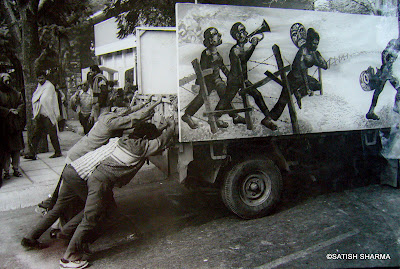by Satish Sharma: Rotigraphy
THURSDAY, 13 SEPTEMBER 2012
“Artist advised to paint works that are pleasing …not satirical…socio political works can only be exhibited during gai jatra..?
Artist’s paintings should be self explanatory? “a picture should speak a 1000 words”.
Artists need to follow traditional parameters while painting religious iconography….modern interpretations will be considered blasphemous
The state can take action against artists if these guidelines are not observed”
Sangeeta Thapa on ?Facebook?quoting or paraphrasing the?official?’police’ reaction.
Watching the Kathmandu gallery episode unfold on social media is a fascinating eye opener . ?So much to learn ?so ?much to think about. so many spaces to open up. in the ?minds of artists and even their local audiences.
At the heart of the incident ?I see ?a dangerous disconnect between local audiences and the Modern Artists ensconced ?in their white cube, sanitising, gallery spaces. Spaces that are about a different audience from a very different, disconnected world. ?A very white and western world which is, at this very moment, in the midst ?of its own actually bloody battle about ?” free speech’ in Libya and the Middle East.
All this, for me personally, has has a sorry sense of deja vu. ?The same battles ?were fought when Safdar Hashmi was murdered in India. ?When ?SAHMAT was formed ?to fight ?cultural wars ?but ended up ?fighting them in drawing rooms and sanitised/santising gallery spaces. ?The street where Safdar had fought his street?theatre battles was ignored ?and SAHMAT?actually?created a rift between itself and his street?theatre ?troupe.

Artists, ignore their?society’s?public?spaces at their own peril. ?By leaving those spaces open to more politically astute and connected to the street others ?they are losing the cultural wars and the cultural spaces that the battles are being, and will be, fought on.
“The problem manish harijan is facing with his exhibition stems from the misinterpretation of his contemporary work…the ugly face of rightist fundamentalism has reared it’s head….Nepal society is by large a tolerant and peaceful one…we need to preserve this please”
Sangeeta Thapa post on facebook
Contemporary, according the Free Dicitionary ?means ??”Belonging to the same period of time”. Within and not just outside a society, one might add .
From Wikipedia, the free encyclopedia comes a more art industry oriented definition
The ‘mixing’, especially in this part of the world, ?is mostly an appropriation of ?popular culture. A simple stealing of signs and symbols to create and sell ?a different ‘national’ look to a bored and?monotonous Modern, Contemporary Art Market.
There is a huge and hugely important debate that has to happen?within the Art world. And it has to happen soon. Around the world, accusations of “blasphemy” are leading to blood flowing on the streets.
In our increasingly connected ?world, no space ?is safe and sanitised. The ?white walls of galleries and museums will be more visible ?and more?violently?attacked ?if cultural?understanding? is not promoted and if cultural bridges are not built. Within societies, especially. Between societies too.
